When you think of outdoor kitchen cabinets, your mind might immediately drift toward materials like stainless steel or PVC. While these two are materials might seem pragmatic for your outdoor kitchen design project, they come with numerous flaws.
When it comes to outdoor kitchen cabinets, your best bet is high-density polyethylene (HDPE), a marine-grade polymer lauded for its weatherproof capabilities and durability.
Why choose HDPE?

If you accidentally spill something on or in an HDPE cabinet, you can clean it quickly with water. The finish on this type of cabinet is tough, so nothing will chip when water blasts from a regular or power washer hose.
You can use an HDPE cabinet as a focal point in an outdoor kitchen because it requires minimum maintenance to keep the surfaces in optimum condition.
Adhesives, glues, beverages, and gooey food can’t stain the HDPE board’s finish as the panels have a protective layer that doesn’t wash away. If rust generates on the material, you can eliminate it easily using a lime cleanser.
Throughout the spring and summer, harsh UV rays will never fade HDPE cabinets because they have ultraviolet inhibitors. When compared to PVC, an HDPE board can withstand high heat more efficiently, which means that you can arrange HDPE cabinetry in direct sunlight without any risks.
When a small or large portion of an HDPE board is scratched, the material doesn’t lose its curb appeal. It continues to stand out because the boards are one solid color. Typically, a stylish HDPE slab will keep its vibrant colorful appearance for years since there are no layers that can degrade or peel.
PVC Misconceptions
PVC is commonly used in outdoor kitchen layouts. However, it has some major risks that consumers must consider. For example, when PVC rests outdoors in most climates, it releases chemicals that can affect people and pets. There are also risks when PVC materials are disposed.
Because PVC is tough to recycle, most people burn it. The problem is that PVC releases chlorine and other compounds when it heats up, and the fumes can decrease air quality in the environment.
Furthermore, it’s not nearly as long-lasting. PVC warps and fades, so it has to be painted for sun protection and you should expect to give it frequent care and maintenance.
Stainless Steel

Stainless steel may be strong and work well indoors, but stainless steel cabinets have disadvantages that may not work for an outdoor kitchen. The top issues include:
- Color clashing: A slab of stainless steel has a bold gray tone that doesn’t blend well with colorful décor in a spring or summer setting. HDPE is customizable and comes in many colors, complementing bright hues in a vibrant outdoor kitchen.
- Frequent maintenance: Stainless steel requires frequent maintenance in an outdoor environment. Without proper care, the finish will corrode and generate spots.
- Environmental risks: When stainless steel rests outdoors for a long length of time, various areas on its surfaces will begin to corrode. Then, gaps will develop on the finish, and bugs may invade through them.
- Heat-prone: Stainless steel absorbs heat and gets hot to the touch in the sun.
Overall, if you want cabinets that are safe, efficient, and stylish, invest in HDPE products. These outdoor kitchen cabinets will provide perks throughout the year with their chic and weatherproof features.
